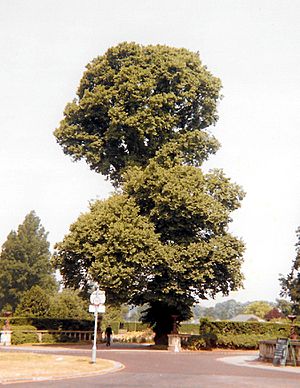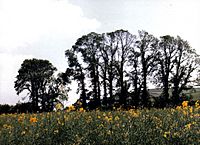Ulmus minor 'Atinia' facts for kids
Quick facts for kids Ulmus minor 'Atinia' |
|
|---|---|

English Elm, Brighton, 1992
|
|
| Species | Ulmus minor |
| Cultivar | 'Atinia' |
| Origin | Italy |
The English elm (Ulmus minor 'Atinia') is a type of elm tree. Before Dutch elm disease spread, it was the most common elm in central southern England. It is one of the largest and fastest-growing deciduous trees in Europe. Deciduous means it loses its leaves in autumn.
Even though it's called "English elm," it didn't originally come from England. Experts believe it came from Atina, Lazio, a town in Italy. The Romans might have brought it to Britain a long time ago. They used this tree to help grow grapevines.
Scientists have found that all English elms are actually clones. This means they are all genetically identical, like copies of a single original tree. They don't grow from seeds because their flowers are sterile. Instead, new trees grow from root suckers or cuttings.
Contents
What is the English Elm?
The English elm is a special type of Ulmus minor, also known as the field elm. It's often called Ulmus procera in many plant guides. But DNA tests show it's a single clone of the field elm. This means every English elm tree is a perfect copy of one original tree.
What Does the English Elm Look Like?
This tree could grow very tall, often over 40 meters (about 130 feet). Its trunk could be wider than 2 meters (6.5 feet). The tallest one recorded in England was 46 meters (151 feet) high!
Leaves and Flowers
The English elm has small, reddish-purple flowers that appear in early spring. They show up before the leaves grow. The fruit is round and flat, called a samara. The leaves are dark green and almost round. They are usually less than 10 cm long. In April, the leaves turn a lighter green, earlier than most other field elms.
Bark and Shape
Older trees have scaly bark. Young English elm suckers can have corky bark. The upper branches of the tree form a fan shape. Lower branches often stick out horizontally. This gives the tree a unique "figure-of-eight" look.
-
English Elm at Powderham, before 1913
What Problems Does the English Elm Face?
The English elm is very vulnerable to Dutch elm disease. This is because all English elms are clones. If one tree can get sick, they all can. The disease is caused by a fungus. It has killed almost all mature English elms in Britain.
Young English elm trees still grow from roots in the countryside. But after about 20 years, these young trees also get infected and die back. Scientists at the University of Abertay Dundee tried to genetically engineer English elms to resist the disease. This was a good tree to experiment with because it doesn't produce seeds. This means there was no risk of it spreading into the wild.
In the United States, the Japanese beetle likes to eat English elm leaves. In the UK, a tiny insect called Stigmella ulmivora mines the leaves.
How Was the English Elm Used?

The wood of the English elm was useful for many things. It was good for water pipes because it resists rot when wet. This made it great for building jetties, piers, and lock gates. It was also used for furniture. However, it wasn't as popular as oak because it could shrink, swell, and split more easily.
People also loved the English elm for its beauty in the English countryside. In autumn, its bright golden leaves made the landscape look amazing.
Where Does the English Elm Grow?
The Romans brought the Atinian elm from Italy to Spain. It was also grown in vineyards in Switzerland. It's believed the Romans brought it to Britain too. They probably used it to support grapevines and as food for animals.
Later, from the 1550s to 1850s, English elms became very popular. They were planted in new hawthorn hedgerows across England. In some areas, there were over 1000 elm trees per square kilometer! People even called it the "Worcester weed" because it grew so much.
Famous avenues of English elms were planted, like in The Backs, Cambridge. One of the most famous was in the Long Walk at Windsor Great Park. It was planted in the 1680s but was cut down in 1943.
The English elm was also taken to Ireland, North America, Australia, and New Zealand. It's still common in Australia and New Zealand, where it's a popular street tree. It can also be found in South Africa.
-
St Peter's Church, Preston Village, Brighton, English elms regrowing after lopping (1951)
-
English elm avenue, Gostwyck, near Uralla, New South Wales (2013)
-
English elms in Cootamundra, New South Wales, one trimmed for power line (2015)
Where Can You Find Notable English Elms Today?
Today, it's rare to find old, mature English elms in the UK. Most were lost to Dutch elm disease. However, some still survive in Brighton and Edinburgh. For example, there's a large tree in Leicester and several in Edinburgh parks.
Many important English elms are found overseas, especially in Australia. They line streets in Melbourne, protected from the disease by their location. There's an avenue of 87 English Elms at All Saints Estate in Rutherglen, Victoria. And 400 English Elms line Royal Parade, Parkville, Melbourne.
In the United States, some beautiful trees survive in Boston and New York City. The famous Hangman's Elm in Washington Square Park is an English elm. In Canada, four 130-year-old English elms are at the University of Toronto.
-
One of three English elms (lower branches removed) around which the Crystal Palace was built for the Great Exhibition, 1851
-
English elm avenue in Fitzroy Gardens, Melbourne (2006)
-
Hangman's Elm, Washington Square Park, New York (2007)
-
One of two large English elms near Trophy Point at West Point, NY (2009)
Brighton's Special Protection Zone
In East Sussex, especially around Brighton, many mature English elms survived. This is thanks to a special "disease management area" or cordon sanitaire. Strong winds from the southwest and the South Downs hills helped protect these trees.
The 'Preston Twins' in Preston Park were possibly the oldest English elms in the world. They had very thick trunks. Sadly, the larger twin was cut down in 2019 after getting Dutch elm disease.
See also
 In Spanish: Ulmus procera para niños
In Spanish: Ulmus procera para niños
























